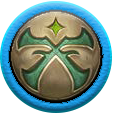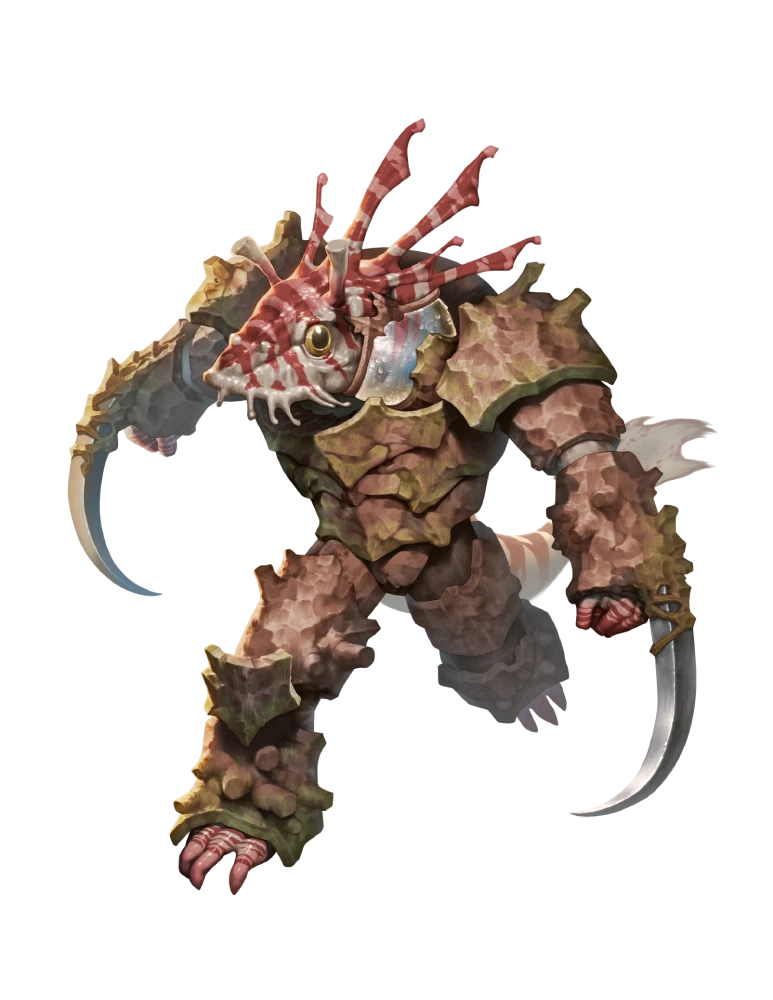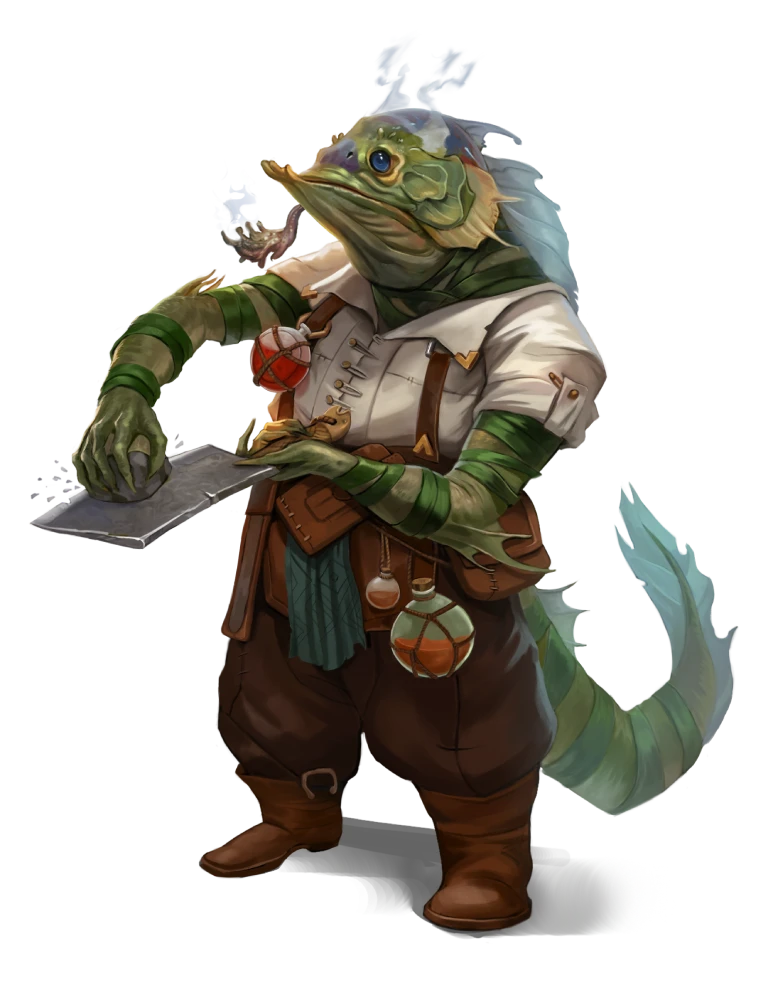
Athamaru
 Uncommon Amphibious Athamaru Humanoid Source Howl of the Wild pg. 17 2.0Athamarus are fish-like humanoids who form tight-knit communities underseas, with villages of siblings led by a common matriarch. Athamarus engage in subsistence farming of seaweed, train eels to serve as mounts, and create elaborate works of coral art.
Uncommon Amphibious Athamaru Humanoid Source Howl of the Wild pg. 17 2.0Athamarus are fish-like humanoids who form tight-knit communities underseas, with villages of siblings led by a common matriarch. Athamarus engage in subsistence farming of seaweed, train eels to serve as mounts, and create elaborate works of coral art.Athamarus are fish-like humanoids who form tight-knit undersea communities. In small settlements, they engage in the subsistence farming of seaweed, train eels to serve as mounts, and create elaborate works of coral art. Their interactions with other aquatic ancestries are strained, as athamarus have suffered mistreatment at their hands. However, they remain curious about potential connections and what new opportunities may offer.
Athamarus define themselves by their connections to the world around them. They live in communal settings among coral reefs and aquatic companion creatures that encourage large families and friend groups. Athamaru settlements established near river or sea trade routes usually maintain strong relationships with the sailors who regularly pass by, exchanging coral jewelry or information about nearby sea routes for surface goods, especially root foods like tubers, yams, and other vegetables, which they see as delicacies.
If you want to play a character who values community and survives the sea through effort alone, you should play an athamaru.
You Might...
- Value your community above most everything else.
- Approach strangers with warm curiosity.
Others Probably...
- Assume you're well versed in underwater survival.
- Believe you're to blame for foul smells.
Physical Description
Athamarus have a distinctive appearance that resembles fish. Their brightly colored skin often matches the reefs where they build their communities. Frills, barbels, and crested fins add to their flamboyant appearance. The sheer variety of crest shapes, scale patterns, and fin styles make individuals distinct, even as communities share features. These similarities are often environmentally advantageous, such as scales that allow them to blend into seaweed or longer toes in areas with stony seabeds. Outsiders often note that athamarus have a distinctive smell, which comes from pheromones, used for both communication and defense. While the level of control varies, all athamarus can communicate basic emotions chemically, and individual settlements have unique variations to their pheromones that serve as a community fingerprint. Masters of pheromonal expression can communicate complex philosophical concepts purely chemically, occupying a role similar to master singers in other communities.
Athamarus value natural adornments that blur the lines between body modifications and jewelry. In areas where coral grows, tending reefs and their symbiotic species are highly valued tasks. Some fashion still-living specimens into earrings or cuffs, then gently guide the coral as it continues to grow. These pieces often stay in circulation for generations and are valued as living community history. Other uses of coral include integrating pieces in with the wearer's body in symbiosis, the coral providing nutrients and the athamaru ensuring access to sunlight and quality water.
Society
The largest population of athamarus lives in the underwater nation of Xidao in Tian Xia. There, smaller city-states follow their own government and leaders, though they have vowed to protect one another from the terrors of the deep should the need arise. The largest city-state, Yashabaru, has no direct control over the other settlements, but its leader serves as a figurehead for the region. Outside of Xidao, communities are more isolated and independent, though population centers include the Shackles, a reclusive settlement near Sedeq, and the large gulfs of Arcadia.
The smallest individual athamaru settlements might have only a dozen members, while the largest house hundreds. Athamaru communities connect with other aquatic inhabitants to build strong bonds that improve the quality of life for everyone involved. Animals are integrated into their communities as partners, particularly the domesticated eels that athamarus use as steeds. The eels generally roam freely, and athamarus train mounts from newly hatched elvers they raise.
Each community consists of genetically related athamarus, typically all born from a single parent. In most settlements, the parent is known as the matriarch and serves as the leader. When this parent nears the end of their life or otherwise stops laying eggs, several athamarus in the community choose to undergo certain physical changes, including an increase in size, to announce their intention to become the next matriarch. The decision to be considered a matriarch isn't taken lightly, as the eventual leadership role is responsible for the community's survival and continuation. Each community selects their next matriarch from these “hopefuls” in their own way. Such traditions include democratic elections, trials of knowledge, and contests of physicality involving deep diving or riding untamed wildlife. In Xidao, citystate matriarch candidates must present themselves to the High Matriarch and their council to be judged worthy of completing the transformation.
Sometimes young adults split off to create new communities, especially if resources become scarce or internal conflict escalates. If a group struggles as they establish a community, their former settlement often agrees to take them back if they agree to respect the extant leadership.
Other groups have mistreated athamarus in the past, so their communities maintain strong internal bonds. Athamarus consider it less risky to deal with each other first. While the most common activities between them are trade, communities also share information. Warnings about danger flow quickly. Safe opportunities are also shared, such as trustworthy land-dwellers and open markets. Such trust with outsiders, however, is easily lost and hard to regain. Most athamarus would rather flee—sometimes even uprooting an entire community—than risk open hostilities.
Beliefs
Due to their community-minded nature, athamarus tend to favor beliefs and philosophies that focus on connection and aiding others. They are also aware that they sometimes require protection from the dangers of the sea, so some athamarus take on the roles of staunch guardians or religious figures who plead for intercession from sympathetic gods. Worship within a single community tends to favor one deity, with multiple temples being rare. In the Inner Sea, athamaru settlements typically revere the nature god
Gozreh to strengthen their bonds with their surroundings or
Erastil for guidance on forming healthy communities. In Tian Xia, the Duke of Thunder
Hei Feng's favor is sought as athamarus navigate fickle seasons and politics, while those athamarus who guard the seas against horrors from the deep pray to the triad war gods Srikalis, Sritaming, and Sribaril for unwavering strength.
Popular Edicts seek out new experiences away from your place of birth, lead your community to a better future
Popular Anathema betray your community or otherwise knowingly do it harm
Adventurers
Athamarus are strongly motivated by community, and most who choose to leave their community to adventure have a good reason why. Many begin adventuring to protect their community or solve a particular problem, while others are thrust out into the wider world after a tragedy. The
animal whisperer,
emissary, and
sailor backgrounds complement athamarus well. Eel-mounted
champions or
rangers often serve as athamaru community protectors, and those who want to connect with others train as
bards. Though athamaru spellcasters are typically rare, some use their strong relationship to the natural world to become
druids.
Names
Athamaru names typically consist of three syllables. The first syllable is shared by all members of a generation, and the last two syllables identify an individual. When traveling outside their communities, they introduce themselves by their community name first. Some communities, particularly those in Xidao, break this convention, but those names still maintain a flow and identify athamarus hatched in the same year.
Sample Names
Aussandor, Cayiel, Corlena, Mithae, Onteac, Paquotal
Other Information
Athamaru Metamorphosis
Any adult athamaru can undergo a metamorphosis to become larger. This typically happens when they intend to become a matriarch. The process doesn’t innately change an athamaru’s understanding of their gender, but is viewed rather as a new stage in their life. Athamarus can metamorphose without their community needing a new matriarch. This most commonly occurs when they intend to leave and form a new community. When a matriarch abdicates, they often slowly transition back from their larger form, though they will always be taller than the average athamaru and typically command some additional respect even after their role as matriarch is a thing of the past.
Athamaru Mechanics
Hit Points
8
Size
Medium
Speed
20 feet
Swim 25 feet
Attribute Boosts
Strength
Wisdom
Free
Attribute Flaw
Intelligence
Languages
CommonThalassicAdditional languages equal to your Intelligence modifier (if positive). Choose from
Alghollthu,
Azlanti,
Fey,
Tien, and any other languages to which you have access (such as the languages prevalent in your region).
You can see in
dim light as though it were
bright light, so you ignore the
concealed condition due to dim light.